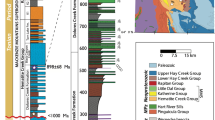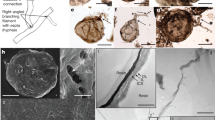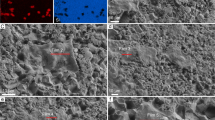Abstract
Structures resembling remarkably preserved bacterial and cyanobacterial microfossils from ∼3,465-million-year-old Apex cherts of the Warrawoona Group in Western Australia1,2,3,4 currently provide the oldest morphological evidence for life on Earth and have been taken to support an early beginning for oxygen-producing photosynthesis5. Eleven species of filamentous prokaryote, distinguished by shape and geometry, have been put forward as meeting the criteria required of authentic Archaean microfossils1,2,3,4,5, and contrast with other microfossils dismissed as either unreliable or unreproducible1,3,6,7. These structures are nearly a billion years older than putative cyanobacterial biomarkers8, genomic arguments for cyanobacteria9, an oxygenic atmosphere10 and any comparably diverse suite of microfossils5. Here we report new research on the type and re-collected material, involving mapping, optical and electron microscopy, digital image analysis, micro-Raman spectroscopy and other geochemical techniques. We reinterpret the purported microfossil-like structure as secondary artefacts formed from amorphous graphite within multiple generations of metalliferous hydrothermal vein chert and volcanic glass. Although there is no support for primary biological morphology, a Fischer–Tropsch-type synthesis of carbon compounds and carbon isotopic fractionation is inferred for one of the oldest known hydrothermal systems on Earth.
This is a preview of subscription content, access via your institution
Access options
Subscribe to this journal
Receive 51 print issues and online access
$199.00 per year
only $3.90 per issue
Buy this article
- Purchase on Springer Link
- Instant access to full article PDF
Prices may be subject to local taxes which are calculated during checkout




Similar content being viewed by others
References
Schopf, J. W. & Packer, B. M. Early Archean (3.3 billion to 3.5 billion-year-old) microfossils from Warrawoona Group, Australia. Science 237, 70–73 (1987).
Schopf, J. W. in The Proterozoic Biosphere: a Multidisciplinary Study (eds Schopf, J. W. & Klein, C.) 25–39 (Cambridge University Press, Cambridge, 1992).
Schopf, J. W. Microfossils of the Early Archean Apex Chert: new evidence of the antiquity of life. Science 260, 640–646 (1993).
Schopf, J. W. in Early Life on Earth (ed. Bengtson, S.) 193–206 (Columbia University Press, New York, 1994).
Schopf, J. W. The Cradle of Life (Princeton Univ. Press, New York, 1999).
Buick, R., Dunlop, J. S. R. & Groves, D. I. Stromatolite recognition in ancient rocks: an appraisal of irregularly laminated structures in an early Archaean chert-barite unit from North Pole, Western Australia. Alcheringa 5, 161–181 (1981).
Buick, R. Microfossil recognition in Archean rocks: an appraisal of spheroids and filaments from a 3500 M.Y. old chert-barite unit at North Pole, Western Australia. Palaios 5, 441–459 (1990).
Summons, R. E., Jahnke, L. L., Hope, M. & Logan, G. A. 2-Methylhopanoids as biomarkers for cyanobacterial oxygenic photosynthesis. Nature 400, 554–557 (1999).
Hedges, S. B. et al. A genomic timescale for the origin of eukaryotes. BioMed Central Evol. Biol. 1, article 4, 1–10 (2001).
Catling, D., Zahnle, K. J. & McKay, C. P. 2001. Biogenic methane, hydrogen escape, and the irreversible oxidation of early Earth. Science 293, 839–843 (2001).
Van Kranendonk, M. J. Volcanic degassing, hydrothermal circulation and the flourishing of life on Earth: new evidence from the c. 3.45 Ga Warrawoona Group, Pilbara Craton, Western Australia. Precambrian Res. (in press).
Nijman, W., De Bruin, K. & Valkering, M. Growth fault control of early Archaean cherts, barite mounds, and chert-barite veins, North Pole Dome, Eastern Pilbara, Western Australia. Precambr. Res. 88, 25–52 (1998).
Strauss, H. & Moore, T. B. in The Proterozoic Biosphere: a Multidisciplinary Study (eds Schopf, J. W. & Klein, C.) 711–798 (Cambridge University Press, Cambridge, 1992).
de Ronde, C. E. J. & Ebbesen, T. W. 3.2 b.y. of organic compound formation near sea-floor hot springs. Geology 24, 791–794 (1996).
Robert, F. Carbon and oxygen isotope variations in Precambrian cherts. Geochim. Cosmochim. Acta 52, 1473–1478 (1988).
Shen, Y., Buick, R. & Canfield, D. E. Isotopic evidence for microbial sulphate reduction in the early Archaean era. Nature 410, 77–81 (2001).
Awramik, S. M. & Semikhatov, M. A. The relationship between morphology, microstructure, and microbiota in three vertically intergrading stromatolites from the Gunflint Iron Formation. Can. J. Earth Sci. 16, 484–495 (1979).
Mendelson, C. V. & Schopf, J. W. in The Proterozoic Biosphere: a Multidisciplinary Study (eds Schopf, J. W. & Klein, C.) 867–951 (Cambridge University Press, Cambridge, 1992).
Kudryatsev, A. B., Schopf, J. W., Agresti, D. G. & Wdowiak, T. J. In situ laser-raman imagery of Precambrian microscopic fossils. Proc. N. Am. Acad. Sci. 98, 823–826 (2001).
Wopenka, B. & Pasteris, J. D. Structural characterization of kerogens to granulite-facies graphite: applicability of Raman microprobe spectroscopy. Am. Mineralogist 78, 533–557 (1993).
Tuinstra, F. & Koenig, J. L. Raman spectrum of graphite. J. Chem. Phys. 53, 1126–1130 (1970).
Oehler, J. H. Hydrothermal crystallization of silica gel. Bull. Geol. Soc. Am. 87, 1143–1152 (1976).
Baker, R. T. K & Harris, P. in Chemistry and Physics of Carbon (ed. Walker, P. L. & Thrower, P. A.) 2–165 (Dekker, New York, 1978).
Grotzinger, J. P. & Rothman, D. H. An abiotic model for stromatolite morphogenesis. Nature 383, 423–425 (1996).
Westall, F. et al. Early Archaean fossil bacteria and biofilms in hydrothermally-influenced sediments from the Barberton greenstone belt, South Africa. Precambr. Res. 106, 93–116 (2001).
Holm, N. G. & Charlou, J. L. Initial idicators of abiotic formation of hydrocarbons in the Rainbow ultramafic hydrothermal system, Mid-Atlantic Ridge. Earth Planet. Sci. Lett. 191, 1–8 (2001).
Lancet, M. S. & Anders, E. Carbon isotope fractionation in Fischer–Tropsch synthesis and in meteorites. Science 170, 980–982 (1970).
Kagi, H. et al. Proper understanding of down-shifted Raman spectra of natural graphite: direct estimation of laser-induced rise in sample temperature. Geochim. Cosmochim. Acta 58, 3527–3530 (1994).
Matthews, D. E. & Hayes, J. M. Isotope-ratio-monitoring gas chromatography – mass spectrometry. Anal. Chem. 50, 1465–1473 (1978).
Clayton, R. N. & Mayeda, T. K. The use of bromine pentafluoride in the extraction of oxygen from oxides and silicates for isotopic analysis. Geochim. Cosmochim. Acta 27, 43–52 (1963).
Acknowledgements
We thank C. A. Stoakes, A. T. Brasier and D. Huston for assistance with field work; N. Charnley, D. Sansom and A. T. Brasier for laboratory support; the Natural History Museum, London, for the loan of the type slides and re-collected material; R. Buick, J. Farmer, J. P. Grotzinger, A. H. Knoll, E. Nisbet, S. Moorbath, J. W. Schopf and R. E. Summons for comments on earlier versions of the manuscript; and The Royal Society, NASA Astrobiology Institute and The Carnegie Institution of Washington for support. This paper is published by permission of the Director of the Geological Survey of Western Australia.
Author information
Authors and Affiliations
Corresponding author
Ethics declarations
Competing interests
The authors declare no competing financial interests.
Supplementary information
Rights and permissions
About this article
Cite this article
Brasier, M., Green, O., Jephcoat, A. et al. Questioning the evidence for Earth's oldest fossils. Nature 416, 76–81 (2002). https://doi.org/10.1038/416076a
Received:
Accepted:
Issue Date:
DOI: https://doi.org/10.1038/416076a
This article is cited by
-
A re-classification of Precambrian cherts: implication on diagenetic origin of chert concretion, nodule and geode
Journal of Sedimentary Environments (2023)
-
Dickinsonia tenuis reported by Retallack et al. 2021 is not a fossil, instead an impression of an extant ‘fallen beehive’
Journal of the Geological Society of India (2023)
-
Lipid biomarkers: molecular tools for illuminating the history of microbial life
Nature Reviews Microbiology (2022)
Comments
By submitting a comment you agree to abide by our Terms and Community Guidelines. If you find something abusive or that does not comply with our terms or guidelines please flag it as inappropriate.



